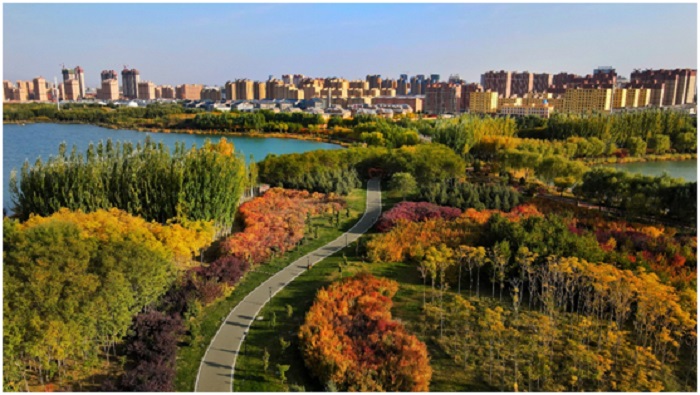



China made unprecedented efforts of pollution control during its 13th Five-Year Plan period (2016-2020), which has obviously improved its ecological environment and pushed the country closer to its goal of becoming wealthier, more prosperous and more beautiful.
Green is the color that marks China’s high-quality development. The country is attracting increasingly more attention from the world with bluer sky, greener mountains and more lucid waters.
China’s rapid green development comes from its ecological conservation efforts. The 18th Communist Party of China (CPC) National Congress held in 2012 incorporated ecological civilization into China’s overall plan for the development of socialism with Chinese characteristics, placing it alongside economic, political, cultural, and social progress to formulate a new and five-pronged approach to building socialism. The 19th CPC National Congress listed the battle for prevention and control of pollution as one of the three critical battles to secure a victory in building a moderately prosperous society in all respects, and agreed to add the statement of “fully understand that lucid waters and lush mountains are invaluable assets” into the Party Constitution.
From becoming a role model in fighting desertification, to pocketing the title of “Champions of the Earth” — the UN’s top environmental honor for three years in a row, and to winning the UN’s Habitat Scroll of Honour Award, China has been widely recognized by the international society for its construction of ecological civilization.
Inger Andersen, Executive Director of the UN Environment Programme, noted that the world needs the Chinese environmental protection philosophy which advocates the harmony between human and nature.
A seed of green contributes to a beautiful world, and a seed of hope leads to a splendid future. The Chinese people’s perseverance in building ecological civilization is shining in the new era. They turned Saihanba in north China, once a vast barren land, into the world’s largest man-made forest, creating a green miracle, which was considered a classic practice to safeguard the earth. From 2015 to 2019, China gained over 71 million hectares of forest area from 2009 to 2019, ranking the first in the world regarding the growth of forest resources in the period. According to satellite observation, a quarter of the newly added forest areas in the world from 2000 to 2017 came from China, and the country was the largest contributor to global net gain in forest area. The Global Forest Resources Assessment 2020 issued by the Food and Agriculture Organization of the UN fully recognized China’s contribution to afforestation and forest protection, and the Australian Financial Review also remarked that China’s 40-year and billion-tree project is a role model for the world.
China has lifted over 3 million people out of poverty through ecosystem services. After 30 years of science-based treatment, the Kubuqi Desert in north China, once known as the “sea of death,” has been turned into a 6,000-square kilometer oasis that lifted over 100,000 local people out of poverty. It demonstrated the effectiveness of the Chinese desertification control that emphasizes both forestation and poverty reduction. It is believed by the international society that the Chinese practice that addresses both economic development and environmental protection is a remarkable exploration, and has contributed Chinese wisdom to the construction of global ecological civilization.
The vigorous promotion of ecological conservation by China, a country with 1.4 billion people, unquestionably has an international influence. From actively implementing the Paris Agreement to pushing the G20 to publish its first Presidency Statement on Climate Change, from raising the initiative to jointly build the Green Silk Road to establishing the South-South Climate Change Fund, and from attaining the 2020 climate action targets ahead of schedule to proactively advancing the post-2020 global biodiversity framework, China has made important contribution to the construction of global ecological civilization as it continuously greened its development.
Chinese President Xi Jinping recently announced at the UN Summit on Biodiversity that China will strive to peak carbon dioxide emissions before 2030 and achieve carbon neutrality before 2060. That exhibits a major country’s resolution to jointly build a prosperous, clean and beautiful planet with the rest of the world, as well as conducts the major country responsibility for the entire human civilization. UK’s science journal Nature said in an editorial that China has charted a greener way forward that can provide important learning opportunities for countries.
As a Chinese saying goes, “Little by little, grains of soil pile up to make a mountain and drops of water converge to form a river.” As China enters a new development phase, it will keep staying committed to the new development philosophy, focus on ecological conservation and green development, and strive to build a beautiful China with green mountains and fresh air.
China will keep playing an important role in promoting global ecological governance and building global ecological civilization, and make its contribution to protecting the planet for the sake of human survival.


Cooperation between China and Nigeria had.



Nigerian government has urged trainees of.



Minister of State for Foreign Affairs,.


The Nigerian Government has congratulated the.


The Humanitarian Service Diamond Awards has.
A Chinese Company, Inner Galaxy Steel.


The Programme Coordinator, Regulatory, Compliance and.


A Non-Governmental Organization (NGO), Committee for.
The Trustfund Pensions Limited has chided.


The House of Representatives Committee on.
Leave a Comment